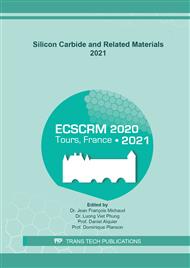p.442
p.447
p.452
p.458
p.463
p.468
p.472
p.477
p.482
Gate Bias Effects on SiC MOSFET Terrestrial-Neutron Single-Event Burnout
Abstract:
Power devices are susceptible to failure by terrestrial neutron single-event burnout (SEB) while in the high-voltage blocking state and above a VDS threshold for that device. Typically, the SEB failure rate is measured at a high blocking voltage, with the source and gate at ground potential. Here the effect of a negative gate bias, commonly applied during MOSFET switching to the blocking state, on the SEB failure rate is examined. It is observed that the SEB failure rate is only weakly dependent on the negative gate bias, because it does not significantly affect the peak field in the drift region where avalanche breakdown is initiated. A negative gate bias of -8VGS in the device blocking state at 1100VDS only results in a 6% increase in the MOSFET SEB failure rate.
Info:
Periodical:
Pages:
463-467
Citation:
Online since:
May 2022
Keywords:
Permissions:
Share:
Citation:


